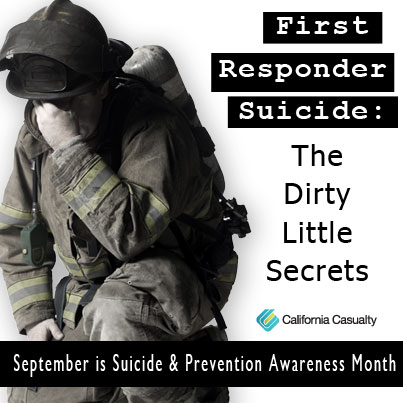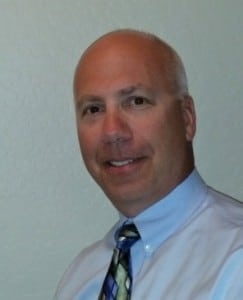By Mark Goldberg, Communications Specialist with California Casualty
September is Suicide Prevention and Awareness Month. A lot of people don’t like talking about it, but it’s time more of us did.
The topic got a lot more personal for me this July when a good friend and retired firefighter, Tim Casey, took his life. Tim had written for the California Casualty blog about his life as a firefighter and the scars (both physical and mental) he carried from his 30 years as a first responder (read here).
I knew Tim had his struggles; he admitted that he was a recovering alcoholic, haunted by the things he saw on the job. He battled PTSD and the desire to drown those images in a bottle of booze. But it appeared things were looking up for Tim. He was engaged to a wonderful woman, was very involved in spreading awareness about first responder suicides and was teaching at one of the local universities. The last time I talked with Tim he seemed up-beat and happy; but I guess the demons were stronger than I or many others knew.
His funeral was moving, but it left me feeling sad and empty. I came away determined to do what I could to help carry on Tim’s mission to alert others about the growing epidemic of firefighter and first responder suicide. Unfortunately, I feel a lot like Sisyphus, struggling to push a giant rock up a hill. Here’s why:
- A new study from Florida State University found half of the 1,000 firefighters they surveyed said they had suicidal thoughts at one or more points in their career. Approximately 15 percent reported one or more suicide attempts.
- A January, 2015 article in USA Today cited National Fallen Firefighters Foundation statistics that a fire department is three times more likely to experience a suicide in a given year than a line-of-duty death. They added that PTSD, depression, substance abuse and suicide are still too common.
And that’s a problem; firefighter ranked number one in CareerCast’s annual survey of the most stressful jobs in 2015, just ahead of soldiers. CareerCast described the profession as, “dangerous in ever-changing conditions, with work not limited to battling blazes; firefighters also assist with medical emergencies and natural disasters.” I can only imagine how the searing image of injury and trauma can impact a person.
And that daily stress, combined with limited opportunities to talk about it, is taking a toll – as evidenced by the number 336. That’s the number of active and retired firefighters in the U.S. who are known to have taken their lives since 2012. It’s what many in the profession call “the hidden dirty secret.”
It was a little discussed topic by fire departments until Captain Jeff Dill created the Firefighter Behavioral Health Alliance (FBHA). Dill started the nonprofit after hearing about the emotional impact the World Trade Towers disaster had on firefighters in 2001, and talking with first responders about lack of mental health resources for those returning from the devastation of Hurricane Katrina in New Orleans. Captain Dill thinks the number of firefighter suicides that get reported is only the tip of the iceberg. He formally began the nonprofit in 2011 to directly educate firefighters/EMS personnel and their families about behavioral health issues such as depression, PTSD, anxiety and addictions, as well as firefighter suicides.
We recently had a chance to talk with Chief Dill about the FBHA and the mission of suicide prevention among the men and women who protect us. Dill also knew Tim Casey.
Tell us a little bit about yourself and FBHA.
I am a recently retired fire officer with over twenty-five years in the fire service, Master’s Degree in Counseling and founder of Firefighter Behavioral Health Alliance (FBHA) I can tell you from experience that looking into ourselves is very difficult.
FBHA is the only known organization that tracks and validates firefighter & EMT suicides in the U.S. We never use names or organizations unless families give us permission plus we take the information known and present workshops across N. America to educate our brothers and sisters.
How does FBHA reach out to Fire/EMS?
We help fire/ems departments learn how to recognize when a coworker is struggling and how to reach out to that person. We had two themes for our workshops until recently. The two were “Challenge With Compassion” and “Be Direct”. The premise was if you see someone struggling, acting different or hear things from them then you need to Challenge with Compassion and Be Direct in your approach. We know that people actually see us better than we see ourselves so listen to them when they tell you “you’ve changed”. I have added the term that so many people have now heard this past year in our workshops and that is we must do an “Internal Size-Up”. This simply means, what is going on in your life? Could these issues become monumental to the point that we become depressed, anxious, create suicidal ideations or become addicted to some type of vice? At times we subconsciously begin to act in ways that only others can see. So when someone says to you “what is going on with you?” please do not take offense, take a look at your life!
Why is it so hard for first responders to ask for help?
In every workshop we deliver we talk about Traditional Brainwashing. This quite simply means we become a product of our training, experiences and historical beliefs. From our first days in either fire or EMS academies we are taught everything to become confident and competent firefighters and EMT’s. Yet, the greatest error is the lack of behavioral health. The instructing of horrific things you will see and how they might play out in your life for a lifetime. The stress, anxiety, depression, sleep deprivation, PTS and relationships that might go south leading to a high rate of divorce are all real issues we face yet never taught because it is a negative for our traditions! We are afraid to talk about it because we are taught not to.
When things are going rough for you then the greatest thing you can do for yourself is to listen. When people, who see us from a different point of view than ourselves, notice that something is different then maybe it is time to look at our lives by performing an Internal Size-Up. This means seek professional help, talk to a chaplain, peer support or just a friend.
We, in the fire and EMS service, must remember we are human beings first. We are performing to standards that the general public will never understand. We are seeing things the general public will never see. So listen to others because maybe they are seeing things in us we will never see!
Stay safe!
We thank Chief Dill for his words and his time.
So, what can we do? First, take the time to ask questions and offer help to a first responder who appears to be stressed, depressed or hurting. In one of his articles for California Casualty, Tim said if someone had really taken the time to press him, to ask him what he was feeling, he probably would have cracked and exposed his hurt.
Slowly, more and more resources are being created to help firefighters deal with the stress of the job. The Firefighter Behavioral Health Alliance is a great first-step, with information and links to support agencies. The National Volunteer Fire Council and the National Fire Protection Association also dedicate numerous resources to linking firefighters in crisis with agencies that can help. Some of those are:
- Emergency Ministries – providing chaplains for first-responder counseling and support, emergencychaplain.org
- Rosecrance Florian Program – offering substance abuse treatment and PTSD support for firefighters and paramedics, https://www.rosecrance.org/substance-abuse/florian-firefighter-treatment-center
- NVFC Fire/EMS Helpline, 1-888-731-FIRE
- North American Firefighters Veteran Network – 24 crisis line for addiction, anxiety, stress and more, firefighterveteran.com
- American Academy of Experts in Trauma Stress – collaborating with organizations to meet the needs of victims and survivors, https://www.aaets.org
- The Code Green Campaign – advocating for mental health awareness and educatio for first responders on how to provide care for themselves and their peers, https://codegreencampaign.org
- The Sweeny Alliance; Grieving Behind the Badge – committed to providing emergency responders and their families training programs, educational material and grief support related to post-traumatic stress and suicide prevention, https://grievingbehindthebadgeblog.net/
In 2004, the National Fallen Firefighters Foundation (NFFF) invited fire organization leaders to a summit on preventing line-of-duty deaths. A document titled “16 Firefighter Life Safe Initiatives” was drawn up to promote health, safety and cultural changes in the firefighting community. Number 13 calls for better access to psychological support and counseling for firefighters and their families addressing the occupational stress they face, and to counter the growing incidence of Post-Traumatic Stress Disorder cases.
The goal of organizations like the NVFC, NFFF and the FBHN is to raise awareness of the problem and to find support for every firefighter and first-responder in need. But, if we don’t talk about the problem, we can’t solve it.
If you know a first responder, maybe someone you love, start the discussion. Ask them what they are feeling, how they are dealing with the stress of the job, and offer help. If you’re thinking there’s not a good time to bring up the subject, remember that this is Suicide Prevention and Awareness Month. Too many good men and women, our protectors, are ending up as statistics in the battle against suicide.
Jeff Dill, Founder of Firefighter Behavioral Health Alliance – NPO (FBHA)
FBHA was established in 2011 to educate firefighters and fire officers on suicide awareness and prevention. He travels the country discussing the data collected on the number of firefighters and EMS personnel who tragically have taken their lives. Through FBHA workshops, attendees are educated through role-play, discussion, and communication skills on how to recognize signs and symptoms of those in distress.
Jeff holds a Master’s Degree in counseling, and recently retired as a Captain from Palatine Rural Fire Protection District in Inverness, Illinois. He is a member of the American Counseling Association, National Board of Certified Counselors, International Association of Fire Chiefs, and a member of the International Association of Fire Fighters.
Jeff also sits on numerous committees including the Florian Program, IAFF, National Volunteer Fire Council, NFPA, as well as a consultant for the Western Massachusetts Fire Chiefs Coalition.
Sources for this article:
https://www.everyonegoeshome.com/2015/09/09/new-suicide-study/
https://grievingbehindthebadgeblog.net/2015/08/23/addiction-suicide-firefighter-sweeney/
https://www.everyonegoeshome.com/16-initiatives/13-psychological-support/
https://www.firerecruit.com/articles/1260782-Quantifying-firefighter-suicides
https://www.firerescue1.com/health/videos/584520–Mental-health-and-firefighting/
https://www.careercast.com/jobs-rated/most-stressful-jobs-2015
- Music & Arts Grant Recipients – 2023 - December 1, 2023
- How to Tell When You Need New Brakes - November 20, 2023
- 20 Best Gratitude Quotes - November 16, 2023


